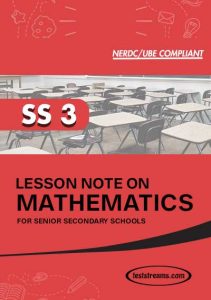This Free Lesson Note on MATHEMATICS for SS3 Note was pulled from our book ( Lesson Note on MATHEMATICS for SS3 MS-WORD ); Compiled to serve as reference material to help teachers draw out their lesson plan easier, saving you valuable time to focus on the core job of teaching.
The Lesson notes are based on the current NERDC curriculum (UBE compliant)[/su_note]
This Free Lesson Note on MATHEMATICS for SS3 Lesson Note Covers The Following Topics
- THEORY OF LOGARITHM
- SURDS: MEANING OF RATIONAL AND IRRATIONAL NUMBERS LEADING TO THE DEFINITION OF SURDS
- APPLICATION OF SURDS TO TRIGONOMETRICAL RATIOS
- MATRICES AND DETERMINANTS
- LINEAR AND QUADRATIC EQUATION
- WORD PROBLEMS LEADING TO ONE LINEAR-ONE QUADRATIC EQUATION; SURFACE AREAS AND VOLUME OF SPHERES AND HEMISPHERICAL SHAPE
- LATITUDE AND LONGITUDE: IDENTIFICATION OF NORTH AND SOUTH POLESTHEORY OF LOGARITHM
WEEK 1
Topic: THEORY OF LOGARITHM
Laws of Logarithms
- Product law
Loga(MN) = loga M + loga N
e.g. log2(2 x 4) = log2 + log2 4
- Quotient law
Loga (M/N) = loga M – loga N
e.g. log10(1000/10) = log101000 – log1010
- Power law
Loga Mp = P loga M
e.g. log223 = 3 log22
4a. loga 1 = 0 where a ¹ 1
4b. logaa = 1 e.g. log1010 = 1, log22 = 1
- Fractional Power
LogaMx/y = x logaM/y e.g. log101003/2
- Root Law
In a special case of 5 when x = 1
LogaM1/x = loga yÖM = logaM/y e.g. log2 161/4 = log2 4Ö16 = log216/4
- Change of base
logaM = 1/logma e.g. log28 = log82
Calculations based on the application of the basic rule
Simplify without using table
- Log2 3Ö8/log24
Log2 81/3/log222
1/3 log223/2log22
Log22/2log22 = ½
- 3 log10102+ log10 10-3
(2)3 log1010 + -3 log1010
6 log1010 + (-3) log1010
6 + (-3) = 3
- ½ log525 – log50.2
= log5251/2 – log51/5
= log5Ö25 – log51/5
= log55 –log51/5
= log5 (5/1/5)
= log5 25 = log552 = 2log55 = 2
Application of Logarithm in Solving Problem Involving Calculations
APPLICATIONS OF EXPONENTIAL AN LOGARITHMIC FUNCTIONS
To solve an exponential or logarithmic word problem, convert the narrative to an equation and solve the equation.
In this section, we will review population problems. We will also discuss why the base of e is used so often with population problems.
Example 1: Suppose that you are observing the behavior of cell duplication in a lab. In one experiment, you started with one cell and the cells doubled every minute. Write an equation with base 2 to determine the number (population) of cells after one hour.
Solution and Explanations:
First record your observations by making a table with two columns: one column for the time and one column for the number of cells. The number of cells (size of population) depends on the time. If you were to graph your findings, the points would be formed by (specific time, number of cells at the specific time). For example, at t = 0, there is 1 cell, and the corresponding point is (0, 1). At t = 1, there are 2 cells, and the corresponding point is (1, 2). At t = 2, there are 4 cells, and the corresponding point is (2, 4). At t = 3, there are 8 cells, and the corresponding point is (3, 8).
It appears that the relationship between the two parts of the point is exponential. At time 0, the number of cells is 1 or 20 = 1. After 1 minute, when t = 1, there are two cells or 21 = 2. After 2 minutes, when t = 2, there are 4 cells or 22 = 4.
Therefore, one formula to estimate the number of cells (size of population) after t minutes is the equation (model)
f (t) = 2t.
Determine the number of cells after one hour:
Convert one hour to minutes. . = 60 min
Substitute 60 for t in the equation. f (t) = 2t:
f (60) = 260 = 1.15×1018
Example 2: Determine how long it would take the population (number of cells) to reach 100,000 cells.
Solution and explanation:
In this example, you know the number of cells at the beginning of the experiment (1) and at the end of the experiment (100,000), but you do not know the time. Substitute 100,000 for f(t) in the equation f (t) = 2t:
100, 000 = 2t
Take the natural logarithm of both sides:
ln(100, 000) = ln(2t)
Simplify the right side of the equation using the third rule of logarithms:
ln(100, 000) = t ln(2)
Divide both sides by ln(2):
t = = 16.60964 min
It would take 16.6 minutes, rounded, for the population (number of cells) to reach 100,000.
Example 3: Write an equation with base 5 that is equivalent to the equation
f (t) = 2t.
Solution and Explanation:
Let’s start with a generic exponential equation with base 5:
f (t) = a . 5bt.
The f(t) represents the size of the population at time t, the t represents the time, and the a and b represent adjusters when we change the base. The value of a is the number of cells (size of population) at the beginning of the study, and the value of b is the relative growth rate based on a base of 5. We need to find the values of a and b.
We know that the population is 1 at time 0, so insert these numbers in the equation
f (t) = a . 5bt.
We have
1 = a . 5b . 0 = a . 50 = a . 1 = a.
We now know that the value of a in the adjusted equation is 1.
Rewrite the equation
f (t) = a . 5bt
with a = 1.
f (t) = 1 . 5bt
which in turn can be rewritten as
f (t) = 5b . t
We know that the population after 1 minute is 2 cells, so insert these numbers in the equation
f (t) = 5b . t
to obtain
2 = 5b . 1.
Solve for b by taking the natural logarithm of both sides of the equation 2 = 5b.
ln(2) = ln(5b).
Simplify the right side of the equation using the third rule of logarithms:
ln(2) = b ln(5).
Divide both sides of the equation by ln(5) and simplify:
b =In(2)/In(5) = 0.43067658075,
rounded to 0.4307.
Insert this value of b in the equation
f (t) = 5b . t,
and the equation is simplified to
f (t) = 50.4307t
We know that the population is 8 after 3 seconds, so use these values to check the validity of the above equation. Substitute 3 for t in the right side of the above equation. If the answer is 8, or close to 8 because we rounded, then the model (equation) is correct. 50.4307(3) = 8.00906, rounded to 8.
We know from the original equation that after 4 seconds, the population is 16. Let’s do a second check. 50.4307(4) = 16.02415, rounded to 16 cells. The check would be closer had we rounded b to more decimals.
ASSESSMENT
- Suppose that you are observing the behavior of cell duplication in a lab. In one experiment, you started with one cell and the cells tripled every minute. Write an equation with base 2 to determine the number (population) of cells after one hour.

Get the complete Lesson Note with more content at very affordable price. Lesson Note on MATHEMATICS for SS3 MS-WORD- PDF
![]()



